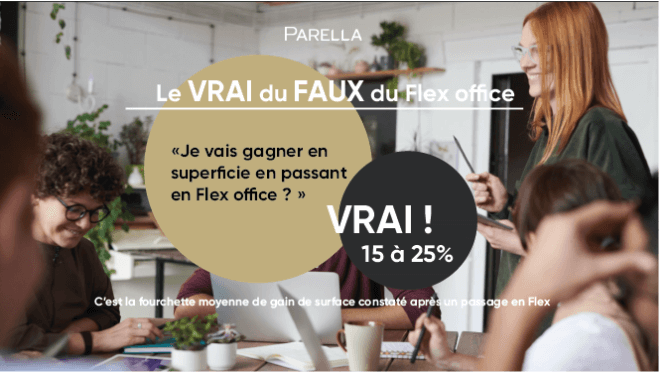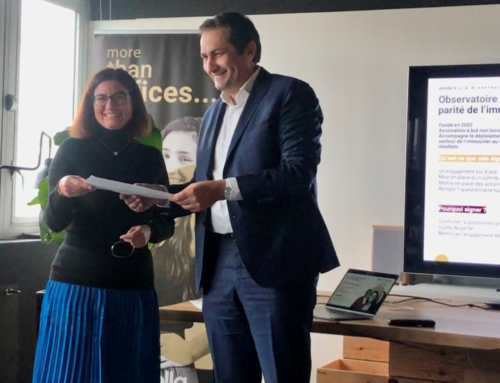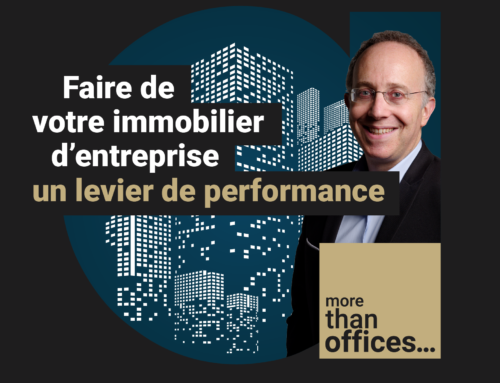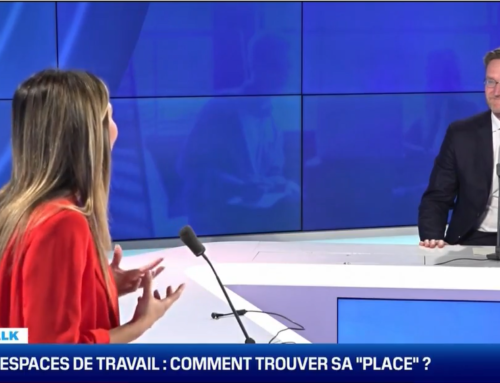The TRUE and FALSE of the FLEX OFFICE

For more than a year, we have been experiencing a massive and uninhibited adoption of telework. This is a considerable advance in the evolution of working methods which questions the role of the office and its occupation. It is obvious that offices are empty! New paradigms with which managers, financial directors, but also human resources directors must deal. It is in this context that the Flex office has naturally reappeared in the real estate debate. Everyone is talking about it, some companies are thinking about it, but few have yet taken the plunge... Definitions and methods differ and many preconceived ideas are circulating about it. Let's take stock of the preconceived ideas that it gives rise to and discover some advice for its implementation.
" I will gain space by switching to Flex office "
TRUE!
15 to 25%... this is the average range of space gain that we generally see after a move to a Flex office. However, after the health crisis, it is a new type of Flex office that is emerging: the ambition is to go further than a simple mathematical liberation of m² and to redistribute the m² gained for the benefit of collective or collaborative spaces corresponding to the "new" needs of the teams. The teleworking policy, the organisation of nomadism, the determination of the rate of expansion, the definition of uses, will all be parameters to be taken into account when sizing spaces and determining potential gains.
"I need to change the layout of my premises to a Flex office "
FALSE!
It is not impossible to see organisations testing the Flex office while keeping the current offices. This works for small teams or in partitioned spaces. For example, two employees are allocated an individual office and work in shifts. Although this solution is not ideal, it does allow for the testing of new practices on teams, but also for the short-term freeing up of office space to meet immediate cash flow needs without the need for works. However, it seems difficult to plan for the long term and this phase should not be seen as the first step in the transition to Flex, but rather as a degraded mode that will undoubtedly be more complicated to promote to employees.
"Flex office contributes to cost reduction
TRUE!
The move to a Flex Office almost systematically allows for the optimisation of m² (a saving of 15 to 25%). As a result, companies will no longer pay rent, charges or taxes on this space. However, these economic gains will only be effective if the company decides to give back the space gained rather than redistribute it.
"I can only go Flex Office if I extend my teleworking policy
FALSE!
The Flex office was born long before telework became widespread! 0.8 (8 workstations per 10 employees): this is the rate of expansion that can naturally be implemented without telework, just with a "classic" company cycle (training days, time off, absence, illness...). Nevertheless, the use of telework can facilitate the adherence to the Flex office, notably against the "empty office" effect, and will allow to reach financially interesting rates of expansion.
"Flex office does not apply to all jobs"
TRUE!
Some specific jobs or jobs that require particularly heavy IT equipment are not eligible for the Flex Office. The profiles and uses must always be studied. On the other hand, more and more profiles that were not considered "compatible" with the Flex office are becoming so, particularly for reasons of exemplary behaviour towards the teams (COMEX, HR teams, etc.).
"The Flex office is a vector of attractiveness for my company
TRUE!
After confinement, 82%* of employees say they want to return to the office to collaborate, share and brainstorm. By betting on the flexibility and diversity of spaces, the entire employee experience, and even the visitor experience, is being rethought, becoming a real asset for the employer brand. There will indeed be fewer workstations than employees, but there will not be fewer working positions, since employees will be able to navigate between concentration zones, brainstorming rooms, coworking spaces, confidentiality bubbles, etc. The optimisation of surface areas will therefore be real, but measured according to the diversity and number of these new places created.
*According to the PARELLA 2020 barometer on the evolution of working methods and office design
"Flex office promotes serendipity
TRUE!
Flex encourages nomadism within the company premises and will naturally create opportunities for chance (but ultimately very organised) encounters which are the essence of serendipity.
"Flex office is easier to implement in open space
TRUE!
This is why we often say that the open space is the launch pad for the flex office: "ready to flex". It is more modular and will allow the surface area dedicated to work spaces to be optimised in favour of collaborative/collective spaces. It will also allow for greater proliferation of large teams, and therefore free up m² for collective spaces or to optimise the surface area.
"Flex office depersonalizes offices and spaces
FALSE!
The Flex office certainly marks a loss of reference points, but individual reference points (MY place, MY photos, MY trophies, etc.), in favour of collective reference points. Flex is therefore an opportunity for the group and the company to assert its value, image and DNA, to give meaning to the offices and spaces, and to put the team at the centre of the dynamic.
"Flex office: an opportunity?
In this context of economic and health crisis, the Flex office has become the main lever for optimising surface areas and also makes it possible to reinforce "activity based working" (=choice of the work environment according to use). Of course, the Flex office is not for everyone, but it is an opportunity to change our relationship with the office, which in the future will be driven less by its statutory aspect and more by the uses it allows.
The Flex office can provide more space for social interaction and collaboration and less space for the more solitary work that can easily be accommodated in a telework format.
Let's keep the best of the office, of the people, of the women, and let's create environments that make people want to be there by adding more style and soul... this could be the recipe for the office of tomorrow and Flex can contribute to it.






